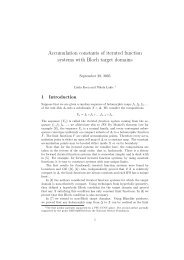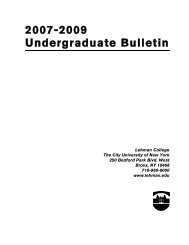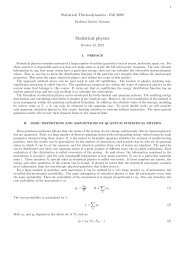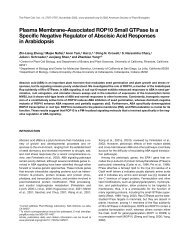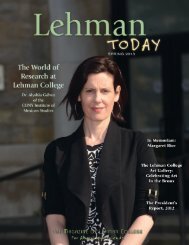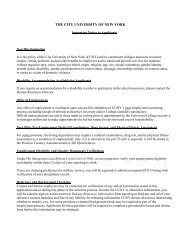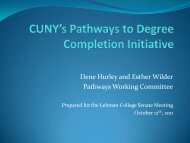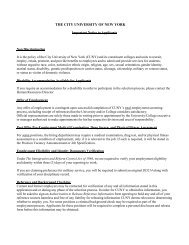You also want an ePaper? Increase the reach of your titles
YUMPU automatically turns print PDFs into web optimized ePapers that Google loves.
1968: <strong>Lehman</strong> <strong>College</strong> Is Established<br />
On July 1, 1968, Herbert H. <strong>Lehman</strong> <strong>College</strong> came into existence,<br />
the first—and still the only—senior CUNY college in the Bronx.<br />
Dr. Leonard A. Lief, a Hunter faculty member since 1955, became<br />
<strong>Lehman</strong>’s first president, a position he would hold for twenty-two<br />
years.<br />
It was up to each faculty member to decide if he or she wanted<br />
to rejoin Hunter <strong>College</strong> on 68th Street or be part of <strong>Lehman</strong>. Although<br />
almost half decided to move downtown, some departments<br />
like History voted unanimously to stay in the Bronx. “We liked it<br />
here,” remembers Professor Emeritus Jacob Judd, who had taught<br />
at Hunter-in-the-Bronx since 1964 and later was chair of the<br />
Department. “We were a community; we were a small group and<br />
very close. We ate together. There was a lot of camaraderie.”<br />
Speaking at the ceremony<br />
marking the joint dedication of<br />
the <strong>College</strong> and the inauguration<br />
of President Lief, U.S.<br />
District Judge Edward Weinfeld<br />
talked about the three great<br />
themes—reason, action, and<br />
freedom—that he saw in the life<br />
of Governor <strong>Lehman</strong> (shown at<br />
right), who had been his close<br />
friend. He could not conceive of<br />
a more fitting memorial, he said,<br />
“than a college dedicated to<br />
the advancement of reason, the<br />
ordering of action, the preservation of freedom.”<br />
“I wanted a change of scene from the city.<br />
I had gone to Hunter <strong>College</strong> High School,<br />
and when we got into Hunter <strong>College</strong> and<br />
we had a choice of staying in Manhattan<br />
or going up to the Bronx, I wanted to go to<br />
the Bronx. They had a campus, and it was<br />
beautiful. There were a lot of green fields<br />
and tennis courts. It was just lovely. Growing<br />
up in Manhattan, you just didn’t have a lot<br />
of green space, except Central Park, of course. One of the things I<br />
recall about the students in those days is that they were committed.<br />
All of us had jobs besides going to school. Everyone had a part-time<br />
job. I met my husband, Ronald, at Hunter-in-the-Bronx. We were the<br />
same year—Class of 1956.<br />
We met in a geography class<br />
in Gillet Hall, I believe. I was a<br />
history major; he was an eco-<br />
nomics/geography major.””<br />
— Natalie Schneider Olsen,<br />
Hunter ‘56<br />
(shown with her husband<br />
Ronald, also Class of ‘56)<br />
“I had a cousin who went to Hunter uptown, and<br />
he was very satisfied with the experience. I used<br />
to drive from my home in Flatbush, Brooklyn.<br />
Students were really friendly, and the campus was<br />
just so green. Growing up in New York City, there<br />
wasn’t a lot of green space. In the spring and<br />
summer, there were a lot of classes on the lawn,<br />
when the weather afforded it.<br />
Some of the teachers were just fantastic. One professor had such an<br />
impact on me that later on, when I wrote my dissertation for my Ph.D.<br />
in sociology at Columbia, I dedicated it to him. His name was Hubert<br />
O’Gorman—he was a fantastic, fantastic professor of sociology. I took<br />
four classes with him. I remember one time, I think it was in 1966,<br />
students were out on strike for something. The administration wanted<br />
to introduce some fee—not tuition—but something. So people were<br />
outside picketing and carrying signs, and then when it was time for<br />
O’Gorman’s class, people started leaving the picket line just so they<br />
could attend his class. That’s how good a teacher he was. He was so<br />
entertaining.”<br />
— Howard Spivak, Hunter ‘67<br />
Since 1968 the campus has been reshaped with new buildings,<br />
like <strong>Lehman</strong> Center for the Performing Arts—which has made the<br />
<strong>College</strong> a premiere cultural destination. In 1990, Dr. Ricardo R.<br />
Fernández became the <strong>College</strong>’s second President, and under his<br />
leadership <strong>Lehman</strong> has added an array of new majors, expanded<br />
its graduate programs, and reached out extensively to the community<br />
to form partnerships, especially in education. A strategic plan<br />
for 2010-2020 outlines bold steps to keep that progress on track.<br />
At the same time, <strong>Lehman</strong> continues to honor its past, as it has<br />
for more than thirty years, in events like the annual Arthur Sweeny,<br />
Jr. Lecture. Dr. Sweeny, a beloved chemistry professor, originally<br />
taught at Hunter-in-the-Bronx but stayed on to establish <strong>Lehman</strong>’s<br />
first pre-medical office before retiring in 1974. During his fortyfour<br />
years of teaching and research, he guided the education and<br />
careers of legions of students—many<br />
of them women—who went on to<br />
become teachers, doctors, and<br />
chemists and exert an immense<br />
impact on their field.<br />
Those themes of dedication to<br />
higher education, community<br />
service, and the art of teaching<br />
have been—and remain—<br />
a consistent part of this<br />
eighty-year odyssey. <br />
26 <strong>Lehman</strong> Today/<strong>Spring</strong> <strong>2011</strong>



